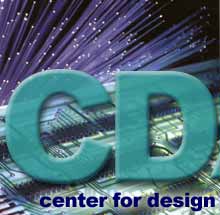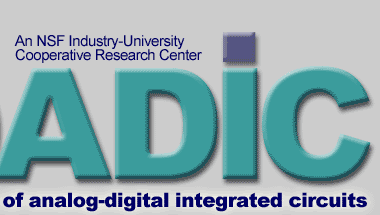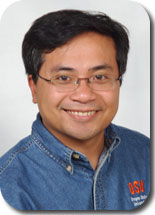I am interested in theories and applications of all things stochastic. My research spans many application areas where chance plays a major role. Recently, I am also interested in optimization methods for signal processing and networking applications. My publications reflect a diverse research interests: network coding, video coding, multimedia networking, wireless communication, peer-to-peer systems, data converter, multimedia security, voxel-based rendering, and quantum computing with focus on quantum walk.
We are grateful for the financial support from following sponsors.


 

Below are links to our recent papers/ theses that hopefully shed more light on our current research.
WiFO system aims to overcome the WiFi overload problem by enhancing wireless capacity using the complement FSO technology which does not interfere with the WiFi transmission bands. When leveraged with the existing high-speed (Gigabit) Ethernet infrastructure, the proposed WiFO system based on the current FSO technology can provide a typical bandwidth of 50 Mbps per user via local transmissions. Unlike stand-alone FSO technology, when integrated with WiFi, the proposed WiFO system provides high mobility via a novel system architecture that enables wireless devices to seamlessly and gracefully receive data simultaneously at different rates from FSO and WiFi channels based on their conditions. Please see the WiFO project website for more detail.
In a current network such as the Internet, information (packets) are sent unchanged from a sender to a receiver via a number of intermediate nodes. Network coding is the notion that allows the information to be "mixed" or more generally "coded" at the intermiedate nodes. It's been shown that in certain scenarios, this network coding approach can result in higher transmission capacities that otherwise, cannot be achieved with the current "unmixed" approach. Network coding also has many applications iin wireless networks as well as distributed data storage. Here are samples of our work in this area.
- T. Duong, T. Nguyen, "Probabilistic Models and Algorithms for Data Synchronization/Broadcast via Network Coding", IEEE Transactions on IEEE Transactions on Vehicular Technology (Supported by National Science Foundation under Grant CNS-0845476 and NSF:EARS 1547450).
- T. Tran and T. Nguyen," Context-Aware Interflow Network Coding and Scheduling in Wireless Networks", IEEE Transactions on Vehicular Technology", IEEE Transactions on Vehicular Technology (Supported by National Science Foundation under Grant CNS-0845476 and CNS-0834775).
- D. Nguyen and T. Nguyen, “Data Synchronization Via Random Network Coding,” ACM MSWiM, 2014
- K. Nguyen, T. Nguyen, Y. Kovchegov, V. Le, "Distributed Data Replenishment," IEEE Transacdtions on Parallel and Distributed Systems, 2012. (Supported by National Science Foundation under Grants CNS-0845476 and CNS-0834775). (source code)
- Dong Nguyen; Thinh Nguyen; Xue Yang, "Joint Network Coding and Scheduling for Media Streaming Over Multiuser Wireless Networks," IEEE Transactions on Vechicular Technology , vol.60, no.3, pp.1086-1098, March 2011 (Supported by National Science Foundation under Grants CNS-0845476 and ECCS-0901883 )
- T. Tran, T. Nguyen, B. Bose, V. Gopal, “A Hybrid Network Coding Technique for Single-hop Wireless Networks,” IEEE Journal of Selected Topics in Advanced Communication (JSAC) - Special Issue on Network Coding for Wireless Communication, 2009. (Supported by National Science Foundation under Grants CNS-0845476 and CNS-0834775)
- D. Nguyen, T. Tran, T. Nguyen, B. Bose, "Wireless Broadcast Using Network Coding, ", IEEE Transactions on Vehicular Technology, 2008. (Supported by National Science Foundation under Grants CNS-0845476) (Winner of the Jack Neubauer Award (Best TVT Transaction Paper of The Year))
Distributed systems have enjoyed much popularity in the last few years due to their scalability. Our research is focused on both architectural design as well as protocols for distributed systems. Our approach to system design is often theoretically motivated. Here are samples of our work in this area.
- T. Duong-Ba, T. Nguyen, B. Bose, D. Tran, "Distributed Client-Server Assignment for Online Social Network Applications," IEEE Transactions on Emerging Topics in Computing, 2015
- T. Duong-ba, T. Nguyen, B. Bose, and T. Tran, “Joint Virtual Machine Placement and Migration Scheme for Datacenters”, IEEE GLOBECOM, 2014.
- H. Nishida and T. Nguyen, "Optimal Client-Server Assignment for Internet Distributed Systems", IEEE Transactions on Parallel and Distributed Systems, 2012
- H. Nishida and T. Nguyen, "Optimal Client-Server Assignment for Internet Distributed Systems", ICCCN 2011.
- H. Nishida and T. Nguyen, "Achieving Fairness in P2P Networks with Global Contributions", IEEE Transactions on Parallel and Distributed Systems, 2010.
- D. Tran and T. Nguyen, "Hierarchical Multidimensional Search in P2P Networks", Computer Communications, Elsvier Journal of Computer Communications - Special issue on Foundation of Peer-to-Peer Computing, 2008
In recent years, sensor networks have emerged as an important class of networks for many military and commercial applications. A sensor network is a collection of wireless communication nodes. Each node is capable of sensing the environment and communicating the measured data to the neighboring nodes, and eventually to the external users. The majority of sensor networks are designed to collect data or to perform anomaly detection. In this research, we study the algorithms and coding techniques for energy efficiency, robustness, accurate localization and collection in sensor networks. Here are samples of our work.
- T. Duong and T. Nguyen, “Data Collection in Sensor Networks via the Novel Fast Markov Decision Process Framework”, IEEE Transactions on Wireless Communications, 2015 (accepted)
- S. Kang and T. Nguyen, "Distance based Thresholds for Cluster Head Selection in Wireless Sensor Networks", IEEE Communication Letters, 2012,
- Kien Nguyen, Thinh Nguyen, and Sen-Ching Cheung, “On Reducing Communication Energy Using Cross-Sensor Coding Technique,” International Journal of Distributed Sensor Networks, vol. 2011, Article ID 837128, 12 pages, 2011.
- D. Tran and T. Nguyen, "Localization In Wireless Sensor Networks based on Support Vector Machines", IEEE Transactions on Parallel and Distributed Systems, 2008
- T. Nguyen, D. Nguyen, H. Liu, D. Tran, "Stochastic binary sensor networks for noisy environments," International Journal of Sensor Networks, Vol 2, No. 6, 2007
Adiabatic time is a recent natural extension of mixing time. Mixing time has been central to the study of convergence time of time homogenenous Markov chains. Similarly, adiabatic time allows one to characterize the convergence time of a time inhomogeneous Markov evolution. Adiabatic time has its root in quantum mechanics which arised from the study of the stability of the ground state of a quantum system by continuous application of Hamiltonian operators. In contrast, our adiabatic time arises from the application of time-varying transition probability operators to a probability density. Our research explores the adiabatic times for various types of non-stationary stochastic processes. Adiabatic time lends itself naturally to stability analysis of many real-world applications of non-stationary nature. For example, below is a sample of our work which uses the adiabatic framework to study stability and convergence time of queuing policies.
- T. Duong and T. Nguyen, “Data Collection in Sensor Networks via the Novel Fast Markov Decision Process Framework”, IEEE Transactions on Wireless Communications, 2015 (accepted)
- D. Nguyen, T. Duong, T. Nguyen, "Network Protocol Designs: Fast Queuing Policy via Convex Relaxation", IEEE Transactions on Communications, Vol. 62, No. 1, January 2014
- T. Duong and T. Nguyen, “Fast Markov Decision Process for Data Collection in Sensor Networks”, IEEE ICCCN 2014 (acceptance rate 29%)
- D. Nguyen, T. Duong, T. Nguyen, IEEE ICCCN, "Fast Queuing Policies for Multimedia Applications", IEEE ICCCN 2013.
- Duong, T., D. Nguyen-Huu, and T. Nguyen, "Adiabatic Markov Decision Process with application to queuing systems", 47th Annual Conference on Information Sciences and Systems (CISS), Baltimore, MD, USA, IEEE, pp. 1 - 6, 03/2013
- L. Zacharias, T. Nguyen, Y. Kovchegov, K. Bradley, "Adaptive Queuing Policies via Adiabatic Approach", IEEE ICNC, 2013
- L. Zacharias, T. Nguyen, Y. Kovchegov, K. Bradford, "Analysis of Adaptive Queueing Policies via Adiabatic Approach," submitted to Journal of Queuing Systems
- T. Duong and T. Nguyen, "Convergence of Value Iteration Algorithm in Adiabatic Settings", Technical Report (6/15/12)
- D. Nguyen, T. Duong, and T. Nguyen, "Achieving Quality of Service via Packet Distribution Shaping", Technical Report (05/15/12)
- K. Bradford, Y. Kovchegov, T. Nguyen, "Stable Adiabatic Times for Markov Chains", submitted to Electronic Journal of Probability (07/19/12)
Our research is focused matrix completion and sparsity reconstruction.
- E. Chunikhina, R. Raich, T. Nguyen, "Confidence-constrained Joint Sparsity Recovery under the Poisson Noise Model"
- E. Chunikhina, R. Raich, T. Nguyen, “Performance Analysis for Matrix Completion via Iterative Hard-Thresholded SVD”, IEEE Statistical Signal Processing, 2014
- E. Chunikhina, G. Gutshall, R. Raich, and T. Nguyen, "Tuning-free Joint Sparse Recovery Via Optimization Transfer", IEEE ICASSP, 2012.
- T. Nguyen, "Robust Data-Optimized Stochastic Analog-to-Digital Converter," IEEE Transactions on Signal Processing, Vol. 55, No. 6, June, 2007
Classical random walk is a well-studied notion and is fundamental to many randomized algorithms in computer science. Quantum walk is an equivalent counterpart in the quantum world. In classical settings, a walk is governed by a transition probability matrix. In the quantum world, the equivalent walk is governed by a unitary operator. For many problems such as factoring, it has been shown that one can construct quantum algorithms running on a quantum computer with exponential speed-up over the classical algorithms. Thus, it is reasonable to expect that studying quantum walk will shed light on many future quantum randomized algorithms.
Our research is focused on characterizing the t-step distribution of various types of quantum walks. Below are samples of our work.
- Zlatko Dimcovic, Daniel Rockwell, Ian Milligan, Robert Burton, Thinh Nguyen, and Yevgeniy Kovchegov, "Framework for discrete-time quantum walks and a symmetric walk on a binary tree" to appear in Physical Review A.
- Robert Burton, Yevgeniy Kovchegov and Thinh Nguyen "Quantum Random Walk via Classical Random Walk With Internal States" (PDF) Technical Report ORST-MATH 10-03 (2010)
I am also interest in other research such as multimedia security and privacy. They are not listed here, but they are by no means of less interest to me. Please see my publications for my other research interests. |





